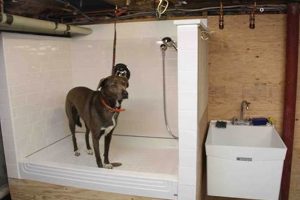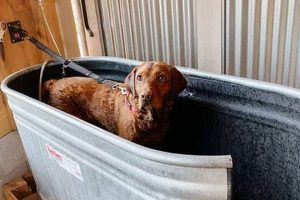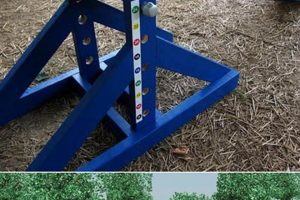Constructing affordable enclosures for canines using readily available materials and do-it-yourself methods constitutes a resourceful approach to pet ownership. This practice typically involves repurposing items such as wooden pallets, chain-link fencing, or even discarded shipping containers to create a secure and comfortable space for dogs. For instance, a basic enclosure might be built by securing reclaimed wooden pallets together to form the walls of a rectangular space.
The advantages of building low-cost dog enclosures are multifaceted. Economically, it reduces the financial burden associated with purchasing pre-fabricated kennels. Furthermore, it offers a sustainable solution by giving a second life to materials that would otherwise contribute to waste. Historically, resourceful pet owners have always sought cost-effective ways to house their animals, and the current emphasis on repurposing reflects a renewed commitment to affordability and environmental consciousness.
The following sections will explore several practical techniques and design considerations for constructing sturdy, budget-friendly dog enclosures. These techniques include step-by-step instructions, material recommendations, and safety considerations to ensure the well-being of the animal housed within.
Practical Advice for Economical Dog Enclosure Construction
The following guidelines offer practical advice for building dog enclosures while minimizing expenses. Careful planning and material selection are essential for ensuring both cost-effectiveness and the animal’s safety and comfort.
Tip 1: Prioritize Reclaimed Materials: Scour local sources for free or low-cost materials. Options include discarded wooden pallets, salvaged fencing, and repurposed metal sheeting. Thoroughly inspect these materials for hazards such as protruding nails or splinters before use.
Tip 2: Optimize Design for Material Efficiency: Plan the kennel dimensions carefully to minimize material waste. Simple, rectangular designs are typically more economical than complex shapes. Consider pre-existing structures, such as sheds or fences, as potential sides of the enclosure.
Tip 3: Secure the Foundation: A stable foundation is crucial for kennel longevity. Even for temporary enclosures, a simple gravel base can improve drainage and prevent soil erosion. For permanent structures, consider sinking posts into the ground for added stability.
Tip 4: Ensure Proper Ventilation: Adequate airflow is vital for the dog’s health and well-being. Design the enclosure to allow for natural ventilation, avoiding completely enclosed spaces. Consider incorporating mesh panels or leaving small gaps between boards.
Tip 5: Implement Weather Protection: Provide shelter from the elements. A solid roof section, even a small one, can offer protection from rain and sun. Orient the kennel to minimize exposure to prevailing winds.
Tip 6: Focus on Secure Fastenings: Use robust fasteners, such as screws or bolts, to secure the kennel structure. Avoid relying solely on nails, which can loosen over time. Regularly inspect fasteners and tighten them as needed.
Tip 7: Prioritize Safety: Eliminate potential hazards, such as sharp edges or small gaps that could trap a dog’s limbs. Use non-toxic paints or sealants if treating the wood. Consider the dog’s size and temperament when designing the enclosure to prevent escapes or injuries.
By adhering to these cost-conscious principles, the construction of a functional and safe dog enclosure can be achieved without incurring significant expenses. Careful planning and attention to detail are paramount for ensuring the long-term suitability of the structure.
The subsequent section will delve into specific project ideas, providing detailed instructions and material lists for various types of budget-friendly dog enclosures.
1. Material Sourcing
Material sourcing directly impacts the economic feasibility and environmental footprint of constructing do-it-yourself, budget-friendly dog kennels. The choice of materials and their procurement significantly influences the overall cost and sustainability of the project.
- Reclaimed Wood Acquisition
The acquisition of reclaimed wood, such as pallets or discarded lumber, represents a primary strategy for reducing material costs. Sourcing these materials from construction sites, demolition projects, or online marketplaces can provide a substantial cost savings compared to purchasing new lumber. However, careful inspection for structural integrity and potential hazards (nails, splinters, chemical treatments) is essential before utilization. Neglecting this inspection can compromise the kennel’s safety and longevity.
- Local Sourcing and Partnerships
Establishing relationships with local businesses, such as hardware stores or lumber yards, can offer access to discounted materials or scrap pieces. These partnerships can provide a consistent source of affordable materials and reduce transportation costs. Furthermore, exploring local classifieds or community bulletin boards can uncover opportunities to acquire unwanted building materials at reduced prices or even for free. Cultivating these local connections streamlines the procurement process.
- Alternative Material Exploration
Investigating alternative materials beyond traditional lumber can further reduce costs. Options include using repurposed metal sheeting for roofing or fencing, employing durable plastics for flooring, or utilizing concrete blocks for foundation support. The suitability of these materials depends on the dog’s size, temperament, and the climate conditions. Thorough research is necessary to ensure the selected materials are safe, non-toxic, and capable of withstanding environmental stressors. Example, PVC piping or livestock panels are affordable, can be used as fencing and easy to assemble.
- Optimizing Material Use and Minimizing Waste
Efficiently utilizing purchased or reclaimed materials is crucial for minimizing waste and maximizing cost-effectiveness. Careful planning of kennel dimensions and design can minimize the amount of material required. Employing techniques such as cutting lumber strategically to reduce offcuts and repurposing leftover pieces for smaller components can significantly reduce overall material consumption. Minimizing waste not only saves money but also contributes to the sustainability of the project. Leftover lumber can be used as a dog house too.
The strategic acquisition of materials directly correlates with the affordability and sustainability of do-it-yourself dog kennel construction. By prioritizing reclaimed materials, cultivating local partnerships, exploring alternative options, and optimizing material utilization, builders can substantially reduce costs while ensuring the creation of a safe and functional enclosure. Careful consideration of material sourcing ensures that the enclosure is both economical and environmentally responsible.
2. Design Simplicity
The principle of design simplicity directly correlates with the feasibility and affordability of do-it-yourself, budget-friendly dog kennels. Complex designs invariably necessitate increased material consumption, more intricate construction techniques, and potentially specialized tools, all of which contribute to elevated costs. Conversely, uncomplicated designs minimize material requirements, simplify the building process, and reduce the need for specialized equipment, thus aligning with the overarching goal of economical construction. For instance, a rectangular kennel constructed from uniformly sized wooden pallets demands less cutting and fitting than a multi-sided structure with varying angles and dimensions.
Furthermore, simplified designs facilitate easier modification and repair. Should damage occur to a component of a simple kennel, replacement or repair is generally straightforward, requiring minimal expertise and readily available materials. A complex design, however, may necessitate custom-built replacement parts or specialized repair techniques, thereby increasing maintenance costs and logistical challenges. Consider the difference between replacing a straight support beam in a basic rectangular kennel versus replacing a curved section in a more elaborate, geometrically complex structure. The former is significantly easier and less expensive to accomplish. Similarly, simple designs improve user accessibility for cleaning and general upkeep, ensuring the maintenance of a sanitary and safe environment for the animal.
In summary, design simplicity serves as a cornerstone of affordable kennel construction. It minimizes material usage, streamlines the building process, simplifies maintenance, and ultimately contributes to the overall cost-effectiveness of the project. While aesthetic considerations may tempt individuals to pursue more elaborate designs, prioritizing simplicity ensures that the primary objective of providing a safe and affordable enclosure is achieved without unnecessary expenditure or complexity. This understanding is practically significant as it directly informs the decision-making process during the planning and construction phases, guiding builders toward choices that promote both economy and functionality.
3. Structural Integrity
Structural integrity represents a paramount consideration when undertaking the construction of do-it-yourself, budget-conscious canine enclosures. The long-term viability, safety, and overall functionality of such structures depend directly on their ability to withstand environmental stressors and the physical forces exerted by the animal housed within. Compromises in structural integrity can lead to enclosure failure, potentially resulting in injury to the dog or escape.
- Foundation Stability
The foundation serves as the bedrock of any kennel structure. In the context of economical builds, this frequently involves utilizing readily available materials such as gravel, compacted soil, or repurposed concrete slabs. Proper foundation preparation, including leveling and ensuring adequate drainage, is crucial to prevent settling, shifting, and subsequent structural weaknesses. Neglecting foundation stability can lead to uneven weight distribution and premature degradation of the entire enclosure. For instance, a kennel built on improperly compacted soil may exhibit significant leaning or collapse over time, particularly in regions with heavy rainfall or freeze-thaw cycles.
- Joint and Fastener Strength
The points at which individual components of the kennel connect represent critical areas of potential failure. The selection and application of appropriate fasteners, such as screws, bolts, or nails, are essential for maintaining structural integrity. Economical builds often rely on readily available fasteners; however, their suitability for outdoor use and resistance to corrosion must be carefully evaluated. Furthermore, proper joint construction techniques, such as overlapping joints or the use of reinforcing plates, can significantly enhance the strength and stability of the overall structure. Incorrectly fastened joints or the use of inadequate fasteners can lead to joint separation and weakening of the enclosure over time.
- Material Load-Bearing Capacity
The chosen materials must possess sufficient strength and rigidity to withstand the anticipated loads. Reclaimed lumber, a common choice in budget-friendly builds, requires careful inspection to assess its load-bearing capacity and identify any signs of decay or damage. Substituting thinner or weaker materials to save costs can compromise the overall structural integrity of the kennel. For example, using inadequately sized wooden supports for a kennel roof can result in sagging or collapse under the weight of snow or heavy rain. A thorough understanding of material properties and load calculations is vital to ensure the safety and stability of the enclosure.
- Resistance to Environmental Factors
Outdoor enclosures are constantly exposed to the elements, including rain, wind, sunlight, and temperature fluctuations. These environmental factors can contribute to the degradation of materials and weaken the structural integrity of the kennel over time. Implementing protective measures, such as applying weather-resistant coatings or designing the structure to promote drainage and ventilation, can significantly extend its lifespan. Neglecting environmental protection can lead to premature rotting of wooden components, corrosion of metal fasteners, and overall weakening of the structure. For instance, a kennel built without proper drainage can experience water accumulation, leading to accelerated decay of the foundation and lower wall sections.
These facets underscore the critical role structural integrity plays in the construction of durable and safe dog kennels, particularly in the context of budget-conscious do-it-yourself projects. Prioritizing sound construction techniques, appropriate material selection, and robust joint design is paramount to ensuring the long-term stability and safety of the enclosure, thereby safeguarding the well-being of the animal housed within. The trade-off between cost savings and structural robustness must be carefully considered to achieve a balance between affordability and reliability.
4. Safety Measures
The intersection of safety measures and do-it-yourself, budget-conscious dog kennel construction represents a critical area of concern. While cost-effectiveness is a primary driver in pursuing DIY solutions, the safety and well-being of the animal must remain paramount. Compromising safety to reduce expenses can have severe consequences, ranging from minor injuries to potentially fatal incidents. The effectiveness of a cheap dog kennel is fundamentally tied to the safety measures incorporated in its design and construction. Cause-and-effect relationships are evident: poorly constructed enclosures lead to escape; untreated wood results in splinters; inadequate ventilation causes respiratory issues. Therefore, the implementation of comprehensive safety protocols forms an indispensable component of successful DIY kennel projects.
The practical application of safety measures extends to various aspects of kennel design and material selection. Smooth, sanded surfaces minimize the risk of cuts and abrasions. Secure latching mechanisms prevent escapes, mitigating the dangers of unsupervised roaming. Non-toxic paints and sealants eliminate the possibility of chemical ingestion. Adequate ventilation systems ensure proper air circulation, reducing the risk of respiratory infections. The structural integrity of the kennel, ensured through robust construction and appropriate material selection, prevents collapse and potential injury. Real-life examples highlight the significance: a dog escaping an unsecured enclosure may be hit by a car; a dog ingesting toxic sealant may suffer organ damage; a dog trapped in a poorly ventilated kennel may succumb to heatstroke.
In conclusion, the construction of economical dog kennels necessitates a strong emphasis on safety measures. The pursuit of cost savings must not overshadow the fundamental responsibility to provide a secure and healthy environment for the animal. Implementing comprehensive safety protocols, from material selection to structural design, mitigates potential risks and ensures the well-being of the dog. While challenges exist in balancing affordability and safety, prioritizing animal welfare remains the guiding principle. This understanding underscores the practical significance of integrating safety measures into every stage of the DIY kennel construction process, reinforcing the broader theme that responsible pet ownership extends to every aspect of their care.
5. Weather Protection
Weather protection is a crucial element in the construction of economical, do-it-yourself dog kennels. The ability of the kennel to shield the animal from adverse environmental conditions directly affects its health, comfort, and overall well-being. Implementing effective weather protection measures is not merely an optional consideration but a fundamental requirement for responsible pet ownership, even within the constraints of a budget.
- Roofing Materials and Design
Selection and design of roofing materials are paramount for providing shelter from precipitation and direct sunlight. Economical options include corrugated metal sheets, repurposed tarpaulins, or even overlapping wooden planks. The design should incorporate a sufficient overhang to prevent rain from entering the enclosure and a slight slope to facilitate water runoff. Neglecting proper roofing can lead to water accumulation, creating damp and unsanitary conditions conducive to the growth of mold and bacteria, potentially compromising the animal’s respiratory health. An example of ineffective design would be a flat roof constructed from a non-waterproof material, leading to water leakage and structural damage.
- Windbreak Construction
Exposure to strong winds can cause significant discomfort and hypothermia, especially during colder months. Constructing windbreaks using strategically placed solid panels or tightly woven fabric can mitigate these effects. The orientation of the kennel in relation to prevailing wind directions is also a crucial consideration. A poorly oriented kennel, lacking windbreaks, exposes the animal to constant drafts, increasing the risk of illness and stress. For instance, positioning the kennel with its opening facing directly into the prevailing wind without any barriers will create a chilling effect.
- Ground Insulation and Drainage
Insulating the kennel floor and ensuring adequate drainage are essential for maintaining a comfortable temperature and preventing moisture buildup. Economical insulation options include using straw, wood shavings, or even discarded carpeting. Proper drainage can be achieved by elevating the kennel slightly off the ground or constructing a gravel base to facilitate water runoff. Ignoring ground insulation and drainage can result in a cold, damp floor, leading to discomfort, arthritis, and other health problems. An example would be a kennel floor that directly contacts the ground with no insulating material, leading to heat loss and moisture absorption.
- Shade Provision
Protection from direct sunlight is critical during warmer months to prevent overheating and heatstroke. Shade can be provided through various means, including a solid roof, strategically placed trees, or shade cloth attached to the kennel structure. Insufficient shade can lead to heat stress, dehydration, and potentially fatal consequences. Consider a kennel with a solid roof for shade and proper ventilation to allow airflow so dog could stay cooler.
The integration of these weather protection measures is crucial for creating a safe and comfortable environment for dogs housed in do-it-yourself, budget-friendly kennels. While cost considerations are important, neglecting weather protection compromises the well-being of the animal and ultimately undermines the purpose of providing shelter. The long-term health and comfort of the dog should be the primary guiding principle in the design and construction of any kennel.
Frequently Asked Questions
The following questions address common inquiries regarding the construction and implementation of affordable, do-it-yourself dog kennels. The aim is to provide clarity and guidance on best practices.
Question 1: What are the most cost-effective materials for building a dog kennel?
Reclaimed wood, such as pallets or discarded lumber, represents a primary low-cost material option. Chain-link fencing, often available used, provides secure containment at a reduced price. Consider also repurposing shipping containers or livestock panels.
Question 2: How can structural integrity be ensured in a budget kennel?
A stable foundation is essential. Use gravel or compacted soil to prevent settling. Employ robust fasteners, such as screws or bolts, to secure joints. Inspect reclaimed materials thoroughly for weaknesses before use.
Question 3: What safety precautions should be taken during kennel construction?
Eliminate sharp edges and protruding nails. Use non-toxic paints and sealants. Ensure adequate ventilation to prevent overheating. Design the enclosure to prevent escapes or entrapment of limbs.
Question 4: How can weather protection be effectively implemented in an affordable kennel?
Construct a roof with a sufficient overhang to protect from rain and sun. Provide windbreaks using solid panels or fabric. Insulate the floor and ensure adequate drainage to prevent moisture buildup.
Question 5: Is a building permit required for constructing a dog kennel?
Local regulations vary significantly. Contact the local zoning or building department to determine permit requirements and any applicable restrictions on kennel size or location.
Question 6: What are the ethical considerations related to building a cheap dog kennel?
The pursuit of affordability should never compromise the animal’s well-being. Ensure the kennel provides adequate space, ventilation, protection from the elements, and a safe and stimulating environment. Regularly assess the suitability of the enclosure to meet the dog’s evolving needs.
Effective, affordable dog kennels require careful planning, responsible material sourcing, and strict adherence to safety protocols. Prioritizing the animal’s well-being is paramount.
The following section will provide practical examples of budget-friendly kennel designs and construction techniques.
Conclusion
The preceding discussion has outlined strategies for constructing economical canine enclosures through do-it-yourself methods. Emphasis has been placed on responsible material sourcing, structural integrity, safety measures, and adequate weather protection. Effective implementation of these principles remains crucial for providing suitable housing for canines without incurring excessive costs.
Further research and careful planning are warranted before undertaking any construction project. The responsible creation of “diy cheap dog kennel ideas” not only serves as an economical solution but also underscores a commitment to animal welfare and resourcefulness. It is incumbent upon individuals to prioritize the well-being of the animal throughout the entire process.







